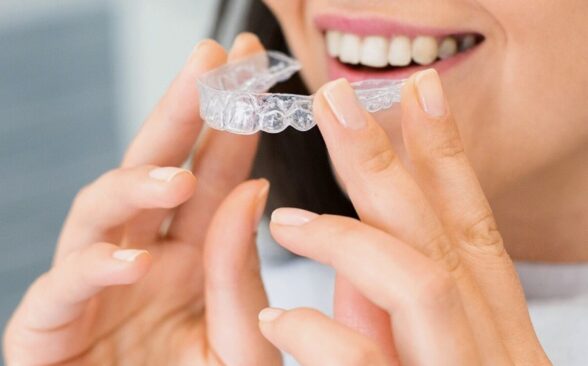Braces vs. Invisalign: Pros and Cons for Your Smile in Leicester
When it comes to straightening your teeth and achieving that perfect smile, you’ve probably heard about two main contenders: traditional braces and Invisalign. Both have their advantages and disadvantages, and knowing what’s right for you can feel overwhelming. In this post, we’ll dive into the pros and cons of braces and Invisalign, helping you decide the best route for your dental journey in Leicester.
What Are Braces?
Braces are the classic choice for orthodontic treatment. They consist of metal or ceramic brackets glued to your teeth, connected by wires and elastic bands. These components work together to apply consistent pressure on your teeth, gradually moving them into the desired position.
Pros of Braces
- Highly Effective: Braces are incredibly effective for treating a wide range of orthodontic issues. Whether you’re dealing with severe misalignment, overcrowding, or bite issues, braces can tackle complex cases that might not be suitable for clear aligners.
- Precise Adjustments: Your orthodontist can make precise adjustments to the brackets and wires, giving you better control over tooth movement. This level of precision can lead to more predictable outcomes.
- No Need for Compliance: Since braces are fixed in place, you don’t have to worry about remembering to wear them. This is especially beneficial for younger patients who might forget to wear their aligners.
- Durable: Made from sturdy materials, braces can handle the daily wear and tear of life. You won’t have to stress about them getting damaged while you eat or go about your day.
- Variety of Options: Braces come in different materials and styles, including metal, ceramic, and even lingual braces (which are hidden behind the teeth). This variety means you can find something that suits your lifestyle and aesthetic preferences.
Cons of Braces
- Aesthetic Concerns: One of the biggest downsides is visibility. Traditional metal braces can feel a bit awkward for those who want to keep their orthodontic treatment discreet, especially for adults and teens.
- Discomfort: Braces can cause some discomfort, particularly after adjustments when the pressure is increased. Soreness is common as your teeth shift.
- Diet Restrictions: If you have braces, you’ll need to avoid certain foods, like hard candies and sticky snacks, to prevent damaging the brackets. This can require a bit of adjustment in your eating habits.
- Oral Hygiene Challenges: Keeping your teeth clean can be trickier with braces. Food can get stuck in the brackets, making thorough brushing and flossing essential to prevent cavities.
- Longer Treatment Time: Treatment with braces often takes longer than Invisalign, typically ranging from 18 months to 3 years.
What Is Invisalign?
Invisalign offers a modern alternative to braces with clear aligners made from a flexible plastic material. These aligners are custom-made for your teeth and are designed to gradually shift them into place.
Pros of Invisalign
- Aesthetically Pleasing: One of the standout features of Invisalign is that the aligners are virtually invisible. This makes them a popular choice for those who want to straighten their teeth without drawing attention.
- Comfortable Fit: Invisalign aligners are smooth and comfortable, causing less irritation to your gums and cheeks compared to traditional braces.
- Removable: You can take your aligners out when eating, drinking, or brushing your teeth. This flexibility means no dietary restrictions, and you can maintain your regular oral hygiene routine.
- Fewer Office Visits: With Invisalign, you’ll typically need fewer trips to the orthodontist for adjustments. Most patients receive several sets of aligners at once, with check-ins every few months.
- Predictable Results: Invisalign uses 3D imaging technology to map out your treatment plan, allowing you to see how your teeth will move over time. This can help you set realistic expectations for your progress.
Cons of Invisalign
- Compliance Required: The success of Invisalign relies heavily on your commitment to wearing the aligners for 20 to 22 hours a day. If you struggle with compliance, you may not achieve the desired results.
- Limited Applicability: While Invisalign works wonders for many cases, it may not be effective for severe misalignment or complex bite issues. Some patients might still need braces.
- Risk of Loss or Damage: Since aligners are removable, there’s a chance of losing or damaging them. If that happens, it can lead to extra costs and delays in your treatment.
- Temporary Discomfort: When switching to a new set of aligners, you may experience temporary discomfort as your teeth adjust. However, this discomfort is generally mild compared to braces.
- Cost: The price of Invisalign can be similar to or even higher than traditional braces, depending on the complexity of your case.
Comparing Braces and Invisalign
Treatment Duration
- Braces: Treatment typically lasts between 18 months to 3 years, depending on your specific needs.
- Invisalign: Most patients complete their Invisalign treatment in about 12 to 18 months.
Cost
- Braces: The average cost ranges from from £2,000 to £5,000, depending on the type and duration of treatment.
- Invisalign: Prices generally fall between £3,000 to £5,500, again depending on complexity. In Thurmaston Dental, Invisalign is from £1,750 only.
Lifestyle Considerations
- Braces: With braces, you’ll need to adapt your eating habits and maintain strict oral hygiene to keep your teeth healthy.
- Invisalign: The removable nature of aligners makes it easier to enjoy your favorite foods and maintain oral hygiene.
Aesthetic Preference
- Braces: Metal braces are quite visible and may not be ideal for those concerned about appearance.
- Invisalign: Clear aligners are discreet, making them an attractive option for adults and teens alike.
Effectiveness for Different Cases
- Braces: Suitable for a wide range of orthodontic issues, including severe cases.
- Invisalign: Best for mild to moderate concerns; more complex cases may require braces.
Making Your Decision in Leicester
Choosing between braces and Invisalign really comes down to your individual circumstances. Here are some tips to help you make the right choice for your smile:
- Consult with a Local Orthodontist: If you’re in Leicester, find an experienced orthodontist who can evaluate your teeth and bite. They can recommend the best treatment option tailored to your needs.
- Think About Your Lifestyle: Consider how each option fits into your daily life. If aesthetics and comfort are a priority, Invisalign might be your best bet. But if you have more complex issues, braces may be the way to go.
- Be Honest About Compliance: Think about your ability to follow through with the treatment requirements. If you’re confident in your discipline, Invisalign could work well for you.
- Check Your Budget: Consider the costs of both options.
Both braces and Invisalign have their unique pros and cons, and the right choice really depends on what’s best for you. While traditional braces are the go-to option for complex cases, Invisalign offers a discreet and comfortable alternative for many.
Take your time to weigh your options, consult with your Leicester orthodontist, and think about what fits your lifestyle and goals. With the right treatment, that perfect smile is closer than you think!
If you have any questions about braces and Invisalign, please get in touch with us today!
Back to Blog




